Get ready to feel the adrenaline rush as the Spanish Grand Prix approaches! This high-octane event is one of the most exciting races on the Formula One calendar, and it’s no surprise why.
With its rich history and thrilling circuit, the Spanish Grand Prix attracts motorsport enthusiasts from all around the world.
F1worldwide.com Recommends
- Austrian Grand Prix: The Ultimate Guide for F1 Fans
- The Austrian GP Circuit a Corner by Corner Breakdown
- British Grand Prix – Learn How to Drive on Silverstone
- Hungarian GP – Drive it and Understand the Sheer Skill Required
- Everything you need to know about Max Verstappen
- Yuki Tsunoda: The Japanese F1 Driver Making Waves
From the track layout to the history of the event, we’ll cover everything you need to know. So buckle up and get ready for an unforgettable ride!
Index
- When Is The 2023 Spanish Grand Prix?
- Where is the Spanish Grand Prix in 2023?
- The Circuit de Barcelona-Catalunya Layout: What to Expect
- Who is Favorite for Spanish Grand Prix?
- History of the Spanish Grand Prix
- Famous Moments In Spanish Grand Prix History
- Where To Watch The 2023 Spanish Grand Prix
- How to Buy Tickets for the 2023 Spanish Grand Prix
- How To Get To Spanish Grand Prix From Barcelona
- Spanish Grand Prix Live
- Tips For Attending The Spanish Grand Prix
- Can you drink at the Barcelona Grand Prix?
- Conclusion
When Is The 2023 Spanish Grand Prix?
The 2023 Spanish Grand prix is being held at the Circuit de Barcelona-Catalunya (Circuit de Catalunya).
It is held between Friday the 2 June 2023 and Sunday 4th June 2023.
Spanish Grand Prix Schedule
The schedule for the 2023 Spanish Grand Prix is listed below.
| 4-June |
| Main Race |
| 15:00 |
| 3-June |
| Qualifying |
| 16:00 – 17:00 |
| 3-June |
| Practice 3 |
| 12:30 – 13:30 |
| 2-June |
| Practice 2 |
| 17:00 – 18:00 |
| 2-June |
| Practice 1 |
| 13:30 – 14:30 |
Spanish Grand Prix Start Time
The 2023 Spanish Grand Prix starts at 15:00 GMT.
Where is the Spanish Grand Prix in 2023?
It takes place at the Circuit de Barcelona-Catalunya (located outside Barcelona), a track that is familiar to both drivers and fans.
The circuit has hosted F1 races since 1991 and has seen some of the sport’s most exciting and memorable moments.
F1 Spanish Grand Prix 2023 Layout: What to Expect

The F1 Spanish Grand Prix is one of the most anticipated races on the calendar.
For the 2023 edition, the circuit will feature a different configuration. The purpose of the change is to modify the dynamics and challenges of the race.
The Circuit de Barcelona-Catalunya is a 4.655 km track located in Montmeló, just outside of Barcelona. The track was originally built in 1991. It has undergone several renovations over the years to improve safety and enhance the spectator experience.
The track is known for its fast and flowing corners, including the famous Turn 3. This is taken at over 200 km/h. There are also several long straights where drivers can reach speeds of up to 330 km/h. The circuit has a total of 16 corners.
It is renowned for providing a true test of a driver’s skill and a car’s performance.
The Chicane Is Gone
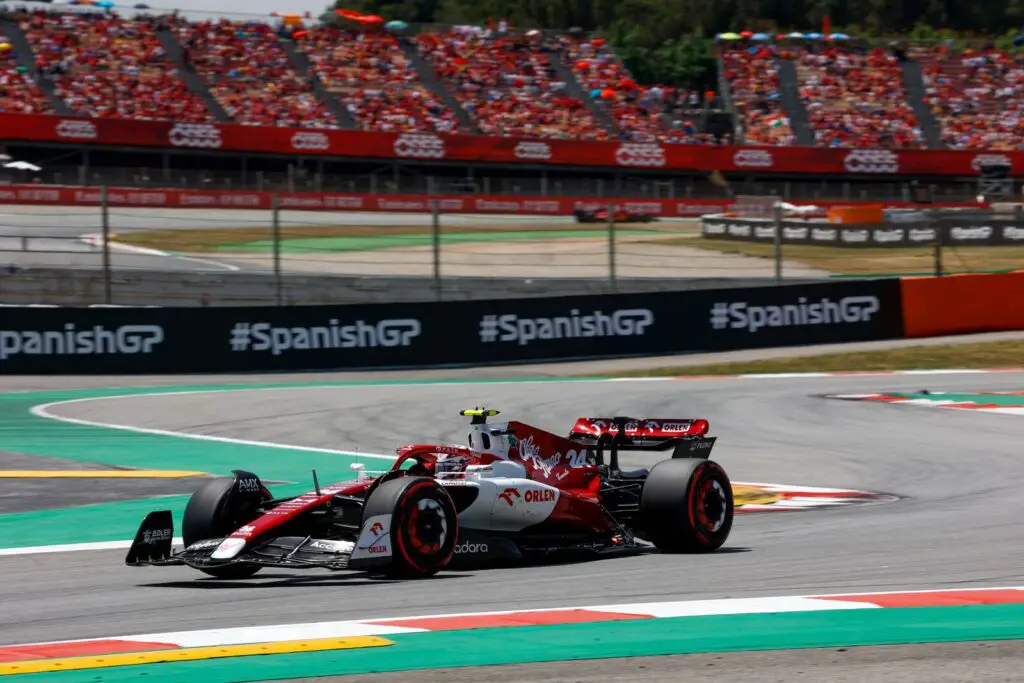
The most significant change for the 2023 Spanish Grand Prix is the removal of the chicane in the final sector of the circuit.
The chicane was introduced in 2007 to slow down the cars before the final corner and create more overtaking opportunities. However, many drivers and fans criticized the chicane for being too tight and disrupting the flow of the track.
The Track Has Been Homologated
The FIA has homologated the track with and without the chicane. This allows the option to use either layout for different motor racing competitions.
For F1, the decision was made to use the layout without the chicane from 2023 onwards. This followed a track inspection by FIA officials in January 2022.
The new layout will restore the original fast and sweeping nature of the final sector. The result is an increasing the speed and thrill of the race.
The cars now approach Turn 16 at over 300 km/h before braking hard for Turn 17, a right-hander that leads onto the main straight. The drivers must be careful not to run wide or lock up their tires. This mistake could cost them time or position.
The new layout will also impact tire wear, fuel consumption, and aerodynamics. The reason for this is that the cars will spend more time at full throttle and less time cornering.
The teams will have to adapt their strategies and setups accordingly. This creates more variety and unpredictability on race day.
The Run-Off Area Is Wider
Another change for the 2023 Spanish Grand Prix is widening the run-off area in Turn 1. This is one of the most critical corners of the circuit.
Turn 1 is a fast right-hander following a long straight, attempting many overtaking moves. However, it is also a corner where many incidents and accidents occur. This is because drivers can run out of space or collide with each other.
To improve the safety of Turn 1, the Circuit de Barcelona-Catalunya has installed new TECPRO barriers. They have also extended the run-off area by 70 meters.
The run-off area now features a gravel trap and a slope of 5%. This will slow down and stop any cars that go off track. The circuit also added a new fence to protect Turns 1 and 2 from debris or flying objects.
The wider run-off area will give more margin for error for the drivers. The result will be that they are able to push harder and take more risks in Turn 1.
However, it will also reduce the penalty for making a mistake. This could encourage more aggressive driving and less respect for track limits. The stewards will have to monitor closely any potential infringements or infractions.
The Circuit Remains A Classic
Despite these changes, the Circuit de Barcelona-Catalunya remains a classic and challenging track that tests every aspect of a car and driver.
The circuit features a mix of high-speed and low-speed corners, elevation changes, and technical sections that require a good balance between performance and reliability.
Catalunya also offers different racing lines and overtaking opportunities, especially in Turns 1, 4, 10, and 17.
The circuit is also affected by weather conditions and track evolution, which can change significantly throughout the weekend.
The wind direction and speed can influence the car’s handling and stability, while the track temperature and rubber can affect the tire performance and degradation. The teams and drivers must be prepared for any scenario and adapt quickly to any changes.
The Circuit de Barcelona-Catalunya track rewards consistency, precision, and skill. It is a track that every driver knows well and can surprise them with new challenges.
The track has produced some of the most memorable Formula One races in the sport’s history.
Who is Favorite for Spanish Grand Prix?
After Max Verstappen’s unmatched winning streak he is the clear favorite for the Spanish Grand Prix.
Hi win at the Monaco Grand prix and Sergio Perez’s poor showing have made Max the bookies firm favorite.
The full list if odds at 1 June 2023 are listed below.
| Driver | BetMGM | Sports Interaction | SkyBet | Neds | Dafabet |
|---|---|---|---|---|---|
| Max Verstappen | -250 | 1.36 | 5-Feb | 1.4 | 1.35 |
| Sergio Perez | 350 | 4.02 | 2-Jul | 4.5 | 4 |
| Fernando Alonso | 800 | 11 | 1-Aug | 9 | 11 |
| Lewis Hamilton | 2200 | 34 | 33/1 | 23 | 34 |
| Charles Leclerc | 2200 | 29 | 25/1 | 23 | 29 |
| George Russell | 2800 | 34 | 33/1 | 26 | 34 |
| Carlos Sainz | 3300 | 41 | 33/1 | 41 | 41 |
| Lance Stroll | 15000 | 153 | 150/1 | 151 | 101 |
| Esteban Ocon | 20000 | 301 | 200/1 | 201 | 251 |
| Pierre Gasly | 20000 | 301 | 200/1 | 201 | 251 |
| Lando Norris | 30000 | 284 | 300/1 | 301 | 251 |
| Yuki Tsunoda | 100000 | 501 | 500/1 | 1001 | 501 |
| Oscar Piastri | 100000 | 501 | 500/1 | 1001 | 501 |
| Valtteri Bottas | 100000 | 501 | 500/1 | 1001 | 501 |
| Alex Albon | 150000 | 501 | 500/1 | 1501 | 501 |
| Nyck de Vries | 150000 | 501 | 1000/1 | 1501 | 501 |
| Kevin Magnussen | 200000 | 501 | 500/1 | 2001 | 501 |
| Nico Hulkenberg | 200000 | 455 | 500/1 | 2001 | 501 |
| Zhou Guanyu | 200000 | 501 | 750/1 | 2001 | 501 |
| Logan Sargeant | 200000 | 501 | 1000/1 | 2001 | 501 |
Where did Lewis Hamilton finish in Spanish Grand Prix?
Lewis Hamilton finished in the 2022 Spanish Grand Prix in 5th position.
With the Mercedes upgrades Lewis Hamilton and George Russel are hoping for a better race in 2023.
Where To Watch The 2023 Spanish Grand Prix

If you are planning to attend the 2023 Spanish Grand Prix and enjoy the vibrant atmosphere of Barcelona, you may be wondering where to sit at the circuit to get the best views of the action.
There are 13 partially covered grandstands with numbered seating, and several grass areas where you can stand and bring your own umbrellas and picnic baskets.
All the grandstands and general admission areas offer views of big screens, where you can watch the race outside of your field of vision, and there is also infrastructure such as toilets and catering areas.
Here are some of the best grandstands to watch the Spanish Grand Prix at Circuit de Barcelona-Catalunya, based on their location, view, price and facilities.
Main Grandstand
The main grandstand of the Circuit de Catalunya is located directly opposite the pit lane and offers a spectacular view of the start-finish straight and the pit lane.
The grandstand has numbered seats and is covered, so you are protected from rain and sun. For main grandstands there are tickets for the lower region and the upper region, where you can enjoy a better view of the circuit.
The main grandstand is the best place to enjoy the build-up on the grid, the start, pit stops, the finish and the podium ceremony.
You can also see some action in Turn 1 and Turn 17, as well as glimpses of other parts of the track through the trees.
The main grandstand is also close to most of the refreshment, merchandise, and entertainment stalls, as well as public transport options.
The main grandstand is one of the most expensive tickets at the circuit, but it is worth it if you want to experience all the excitement and drama of a Formula 1 race.
Grandstand K
Grandstand K is located at Turn 1, one of the most critical corners of the circuit.
Turn 1 is a fast right-hander that follows a long straight, where many overtaking moves are attempted. However, it is also a corner where many incidents and accidents occur, as drivers can run out of space or collide with each other.
Grandstand K offers a great view of Turn 1 and part of Turn 2, as well as some action in Turn 17 and Turn 18.
You can also see some pit lane activity from this grandstand. Grandstand K has numbered seats and is partially covered by trees. There are also big screens opposite this grandstand, where you can follow
How to Buy Tickets for the 2023 Spanish Grand Prix

The 2023 Spanish Grand Prix is one of the most anticipated races of the Formula 1 season, as it takes place at the Circuit de Barcelona-Catalunya. The track that offers a great combination of speed, technicality, and excitement.
If you want to witness the action live and enjoy the vibrant atmosphere of Barcelona, here is how to buy tickets for the 2023 Spanish Grand Prix.
Choose Your Ticket Type
There are different types of tickets available for the 2023 Spanish Grand Prix, depending on your budget, preferences, and availability. You can choose from:
3-day tickets: These tickets give you access to the circuit from Friday to Sunday and allow you to choose from a range of grandstands or general admission zones. The prices range from $208.77 for general admission to $663.56 for grandstand M.
2-day tickets: These tickets give you access to the circuit on Saturday and Sunday, and are only available for grandstand F, which is located at the end of the main straight. The price is $1310.00 per ticket.
1-day tickets: These tickets give you access to the circuit on either Friday, Saturday, or Sunday, depending on your choice. The prices vary depending on the day and the grandstand. For example, a ticket for grandstand G on Sunday costs $530.58, while a ticket for grandstand A on Friday costs $453.70.
F1 Experiences packages: These packages offer premium seats, Champions Club hospitality and exclusive trackside activities in Barcelona.
You can choose from different options such as Starter Package, Trophy Package or Hero Package, which include different benefits such as pit lane walks, driver appearances or podium photo opportunities. The prices range from $999.00 to $3999.00 per package.
Buy Your Ticket Online
The easiest and most convenient way to buy your ticket for the 2023 Spanish Grand Prix is online. You can use one of the following websites:
Grand Prix Events: This is an official ticket agent for the race at Circuit de Barcelona-Catalunya.
You can browse through different ticket types and prices and book your ticket securely with a credit card or PayPal. You can also contact them for more information or assistance.
Formula1.com: This is the official website of Formula 1, where you can find all the information and news about the race and the sport.
You can also buy your ticket online through their partner website, tickets.formula1.com, which offers a similar service as Grand Prix Events.
F1 Experiences: This is the official experience provider of Formula 1, where you can find all the details and prices of their exclusive packages for the 2023 Spanish Grand Prix.
You can also book your package online with a credit card or PayPal.
Receive Your Ticket by Email or Post
After you buy your ticket online, you will receive a confirmation email with your booking details and instructions on how to receive your ticket.
Depending on the website you use and the type of ticket you buy, you may receive your ticket by email or post.
Email: If you buy your ticket from Grand Prix Events or F1 Experiences, you will receive your ticket by email as an e-ticket or a voucher.
You will need to print it out and bring it with you to the circuit, where you will exchange it for a wristband or a hard copy ticket at a designated collection point.
Post: If you buy your ticket from Formula1.com, you will receive your ticket by post as a hard copy ticket.
You will need to provide your delivery address and pay an extra fee for shipping. You will receive your ticket a few weeks before the race.
Enjoy Your Race Weekend
Once you have your ticket in hand, you are ready to enjoy your race weekend at the 2023 Spanish Grand Prix.
You will need to bring your ticket with you to the circuit every day, along with a valid ID and any other documents required by the organizers.
Spectators will also need to follow the rules and regulations of the circuit, and you must not bringing any prohibited items.
You can also make the most of your race weekend by exploring Barcelona and its attractions, such as La Sagrada Familia, Park Guell or La Rambla. You can also sample some of its delicious cuisine, such as paella, tapas, or sangria.
How To Get To Spanish Grand Prix From Barcelona
The Spanish Grand Prix is one of the most popular and exciting races on the Formula 1 calendar, as it takes place at the Circuit de Barcelona-Catalunya, a track that tests every aspect of a car and driver.
If you are planning to attend the 2023 Spanish Grand Prix and enjoy the vibrant city of Barcelona, here is how to get to the circuit from Barcelona.
Get To Spanish Grand Prix By Train
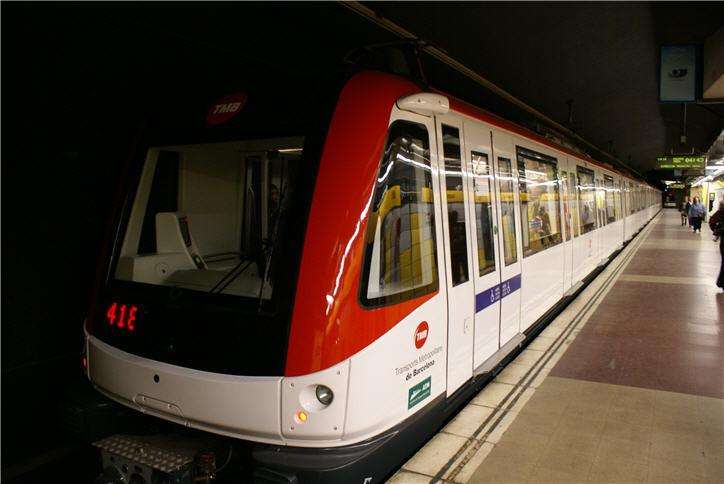
The train is the most affordable and convenient way to get to the Spanish Grand Prix from Barcelona.
The nearest train station to the circuit is Montmelo, which is about 30 minutes away from Barcelona by commuter train.
You can take the train from various stations in Barcelona, such as Sants, Passeig de Gracia or Arc de Triomf, and get off at Montmelo. The trains run every 30 minutes and cost about €4.60 for a return ticket.
From Montmelo station, you can either walk to the circuit (about 45 minutes) or take a shuttle bus (about 10 minutes) that runs every 15 minutes and costs €2.50 for a return ticket.
The shuttle bus stops at different gates of the circuit, depending on your ticket type and grandstand.
Get To Spanish Grand Prix By Taxi
If you prefer more comfort and flexibility, you can take a taxi from Barcelona to the Spanish Grand Prix. The taxi ride takes about 25 minutes and costs about €40-€50, depending on traffic and your destination. You can find taxis at various locations in Barcelona, such as the airport, train stations or hotels, or book one online or by phone.
However, taking a taxi to the circuit may not be the best option on race day, as there may be long queues and delays due to traffic congestion and road closures.
You may also have difficulty finding a taxi back to Barcelona after the race, as there may be high demand and limited availability.
Get To Spanish Grand Prix By Car
If you have your own car or rent one, you can drive from Barcelona to the Spanish Grand Prix.
The circuit is about 30 km away from Barcelona and can be reached by two main roads: the C-17 (Montmelo exit) or the AP-7 toll road (exit 13, 14 or 15).
The drive takes about 40 minutes but may take longer on race day due to traffic.
If you drive to the circuit, you will need to park your car at one of the designated parking areas around the circuit.
The parking areas are free of charge and have different access points depending on your ticket type and grandstand. You will need to follow the signs and instructions of the staff to find your parking area.
Get To Spanish Grand Prix By Bus
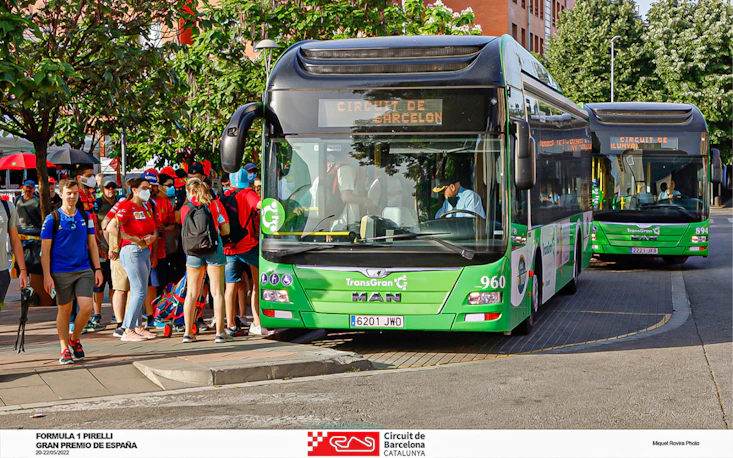
Another option to get to the Spanish Grand Prix from Barcelona is by bus.
There are several bus companies that offer direct services from Barcelona to the circuit on race day, such as Sagales or Autocares Julia. The bus ride takes about an hour and costs about €15-€20 for a return ticket.
You can book your bus ticket online or by phone in advance or buy it on the spot if there are seats available.
The buses depart from various locations in Barcelona, such as Plaza Catalunya or Plaza Espanya, and drop you off at different gates of the circuit, depending on your ticket type and grandstand.
Get To Spanish Grand Prix By Bike
If you are feeling adventurous and eco-friendly, you can also get to the Spanish Grand Prix from Barcelona by bike.
The bike ride takes about two hours and covers about 40 km of mostly flat terrain. You will need to follow a bike path that runs along the coast from Barcelona to Mataro, then take a secondary road that leads to Montmelo and the circuit.
If you bike to the circuit, you will need to park your bike at one of the bike racks that are available near some of the gates of the circuit.
You will need to bring your own lock and secure your bike properly. You will also need to wear a helmet and follow the traffic rules and regulations.
Spanish Grand Prix Live

The Spanish Grand Prix is one of the most exciting and challenging races on the Formula 1 calendar, as it takes place at the Circuit de Barcelona-Catalunya, a track that tests every aspect of a car and driver.
Here is how to watch the Spanish Grand Prix live from anywhere in the world.
Spanish Grand Prix Live – By TV
The Spanish Grand Prix is broadcast live on TV in nearly every country around the world.
Depending on where you live, you may have access to free-to-air or pay TV channels that show the race. Here are some of the main TV broadcasters for the Spanish Grand Prix:
Europe: Austria – Servus TV / ORF; Belgium – RTBF / Telent / Play Sport Open; Czech Republic – AMC; Denmark – TV3 / TV3 Sport / Viaplay; Finland – Viaplay; France – Canal+; Germany – Sky / RTL; Greece – ERT / Cosmote TV; Hungary – M4; Italy – Sky; Netherlands – Viaplay; Poland – Eleven Sports; Portugal – Sport TV; Spain – Movistar / DAZN; Sweden – Viaplay / V sport motor / TV 10; Switzerland – SRF / RSI / RTS; UK – Sky Sports F1
Americas: USA – ESPN2; Canada – RDS / RDS2 / TSN / Noovo; Latin America – Fox Sports / ESPN
Asia: China – Great Sports TV / Guangdong TV; India – Star Sports; Japan – Fuji Television; Malaysia – Astro Sports Indonesia- 0 Channel / Champions TV / Vidio; Singapore – Singtel / Starhub; Thailand – True Visions; Turkey – S Sport / S Sport Plus; Vietnam – K+
Oceania: Australia – Fox Sports / Network 10; New Zealand – Spark Sports
Africa: Africa – SuperSport
You can check your local listings for the exact channel and time of the race in your country.
Spanish Grand Prix Live By Streaming
If you don’t have access to a TV or prefer to watch the race online, you can also stream the Spanish Grand Prix live on various platforms.
Depending on where you live, you may have access to official or unofficial streaming services that show the race. Here are some of the main streaming options for the Spanish Grand Prix.
F1 TV:
This is the official streaming service of Formula 1, which offers live and on-demand coverage of every session of the Spanish Grand Prix, as well as exclusive features, documentaries, and archive footage.
You can subscribe to F1 TV in selected countries for a monthly or annual fee and watch it on your device of choice.
However, F1 TV is not available in some countries due to broadcasting rights restrictions.
Sky Go / Now:
These are the streaming services of Sky, which holds the exclusive rights to show Formula 1 in the UK.
You can watch the Spanish Grand Prix live on Sky Go if you are a Sky Sports subscriber, or on Now if you buy a Sky Sports pass.
You can watch both services on your device of choice, but they are only available in the UK or with a VPN.
Movistar+ / DAZN
These are the streaming services of Movistar and DAZN, which share the rights to show Formula 1 in Spain. You can watch the Spanish Grand Prix live on Movistar+ if you are a Movistar subscriber, or on DAZN if you buy a DAZN pass.
You can watch both services on your device of choice, but they are only available in Spain or with a VPN.
ESPN+
This is the streaming service of ESPN, which holds the rights to show Formula 1 in the USA.
You can watch the Spanish Grand Prix live on ESPN+ if you are an ESPN+ subscriber, or if you have access to ESPN2 through your cable or streaming provider.
You can watch ESPN+ on your device of choice, but it is only available in the USA or with a VPN.
By VPN
If you don’t have access to any of the above options, or if you want to watch the Spanish Grand Prix live for free from another country, you can use a VPN (virtual private network) to bypass geo-restrictions and access streaming services that are not available in your region
Formula 1 In Spain: A Passionate Affair
Spain is a country with a long and rich history of motor racing, especially in Formula 1.
The Spanish Grand Prix is one of the oldest and most prestigious races on the calendar and has witnessed some of the most thrilling and dramatic moments in the sport.
Here are some of the reasons why Formula 1 in Spain is a passionate affair.
Famous Moments In Spanish Grand Prix history
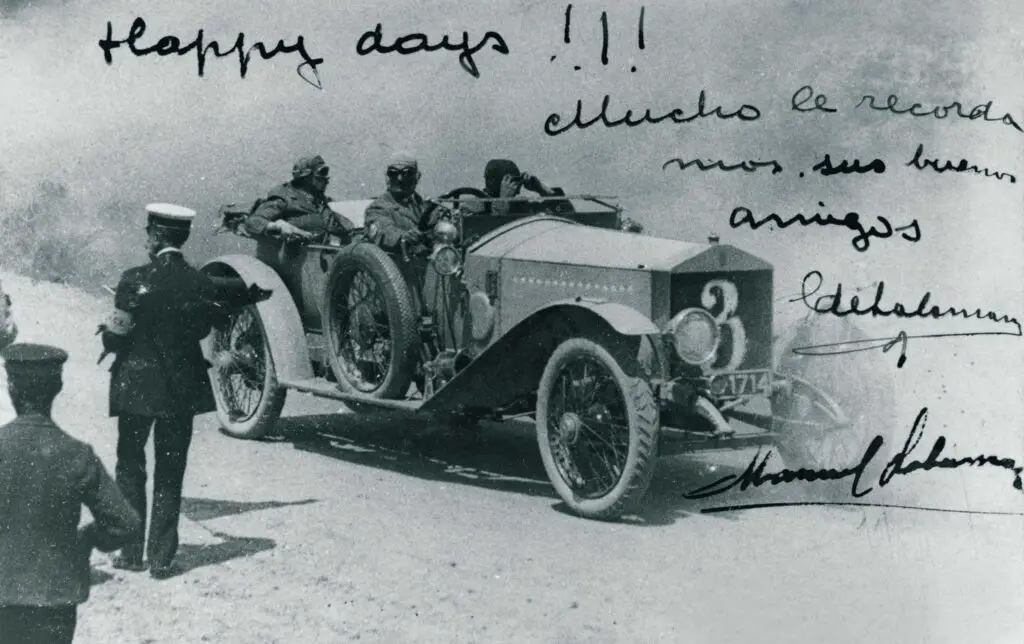
The first race that was considered a Spanish Grand Prix took place in 1913, on a road circuit near Madrid. It was a race for touring cars and was won by Carlos de Salamanca with a Rolls-Royce.
The race was not part of the Formula 1 World Championship, which started in 1950.
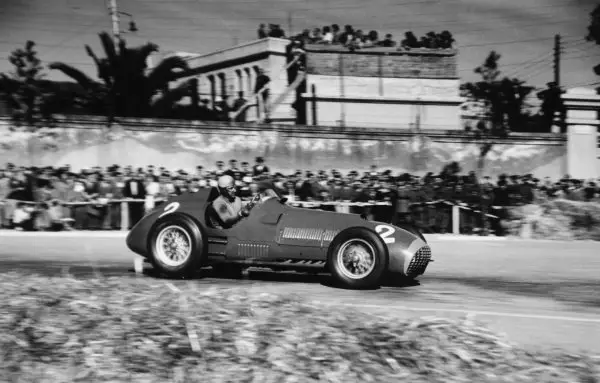
The first Spanish Grand Prix that was part of the F1 World Championship was held in 1951, at a street circuit in Barcelona called Pedralbes.
Key Moments And Famous Races
Over the years, the Spanish Grand Prix has produced some incredible moments and unforgettable races. Here are just a few of the highlights:
- 1981: Gilles Villeneuve wins a thrilling race at the Jarama circuit, just 0.22 seconds ahead of Jacques Laffite.
- 1991: Ayrton Senna and Nigel Mansell engage in an epic battle for the lead, with Senna ultimately coming out on top.
- 1994: Michael Schumacher wins in controversial fashion, serving a two-race ban for ignoring a black flag and then colliding with Damon Hill.
- 2012: Pastor Maldonado takes a shock win for Williams, the team’s first victory in eight years.
- 2016: Max Verstappen becomes the youngest-ever Grand Prix winner at just 18 years old.
These moments are just a small sample of the excitement that the Spanish Grand Prix has to offer. With its fast and challenging circuit, there is always the potential for drama and surprises.
The race was won by Juan Manuel Fangio, the legendary Argentine driver who would go on to win five world titles.
Pedralbes hosted two more F1 races, in 1954 and 1956, before being banned for safety reasons.
The Spanish Grand Prix returned to F1 in 1968, after a decade of absence.
Jarama And Montjuic Circuits
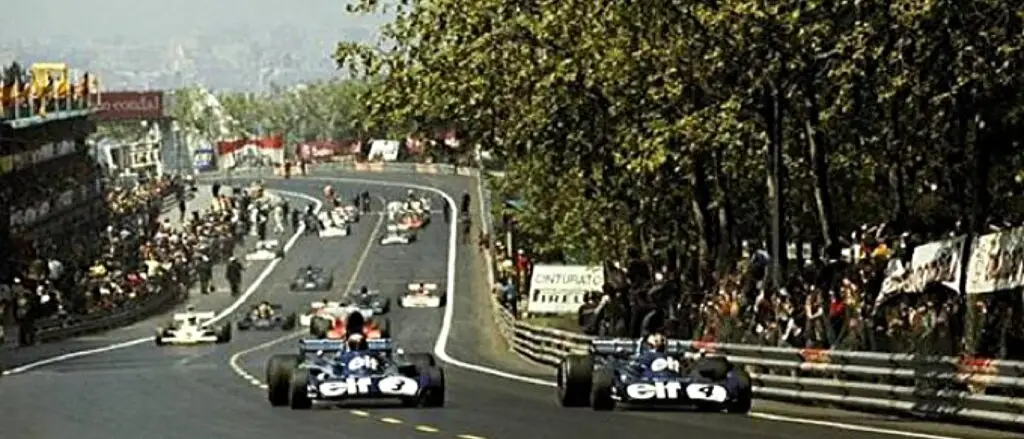
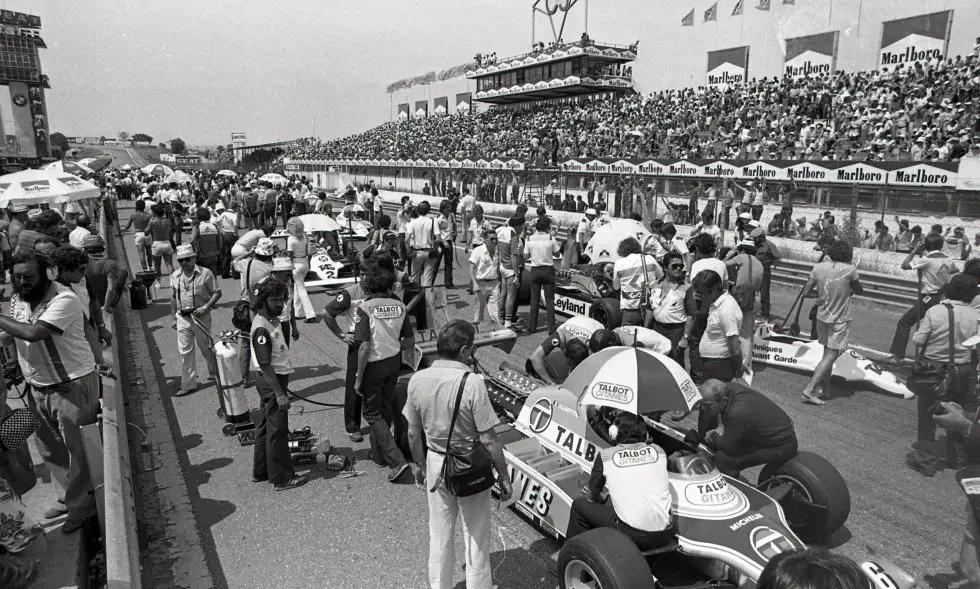
The race alternated between two circuits: Jarama, a permanent track near Madrid, and Montjuic, a street circuit in Barcelona. Both circuits were challenging and exciting and saw some memorable races and drivers. Jarama hosted 10 F1 races until 1981, while Montjuic hosted four races until 1975.
The Jerez Circuit
In 1986, the Spanish Grand Prix moved to a new circuit in Jerez, in the south of Spain.
The circuit was fast and flowing. The F1 event was hosted for seven F1 races until 1990.
The most famous race at Jerez was the 1986 edition, which saw a thrilling three-way battle between Ayrton Senna, Nigel Mansell, and Alain Prost.
Senna won by just 0.014 seconds over Mansell, the closest finish in F1 history.
Circuit de Barcelona-Catalunya

Since 1991, the Spanish Grand Prix has been held at the Circuit de Barcelona-Catalunya, a modern and technical track that is also used for testing.
The circuit has hosted 31 F1 races so far and has seen some of the greatest drivers and teams dominate.
Michael Schumacher holds the record for most wins at Catalunya with six, while Lewis Hamilton has five wins.
Ferrari is the most successful constructor with 12 wins.
The Spanish Drivers: A Legacy of Talent
Spain has produced some of the most talented and successful drivers in Formula 1 history.
Alfonso de Portago
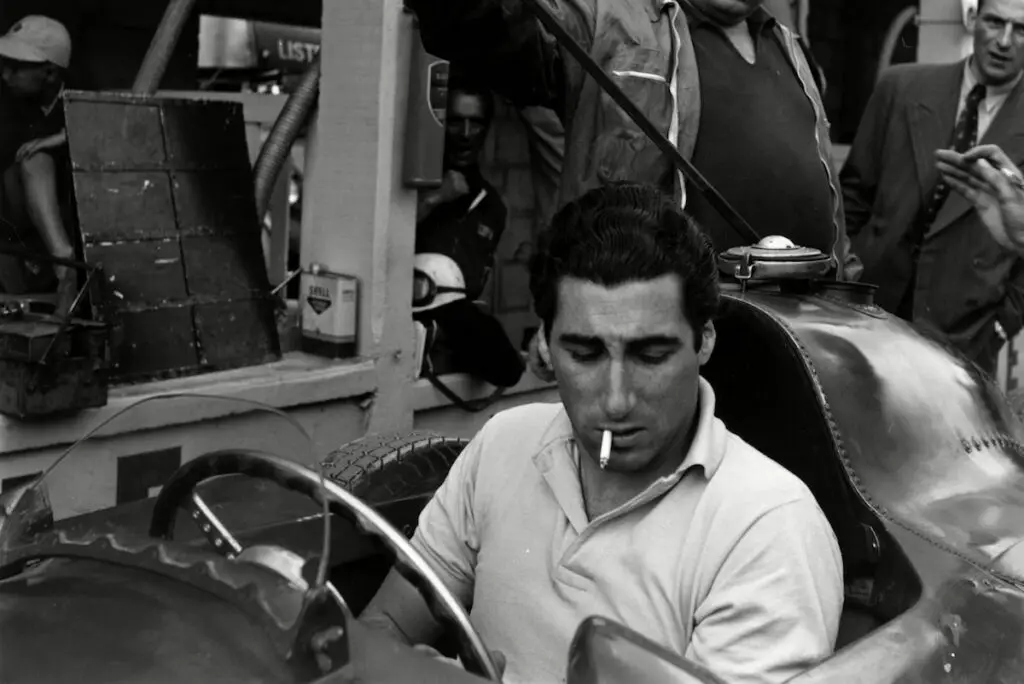
The first Spanish driver to compete in F1 was Alfonso de Portago, who raced for Ferrari in 1956 and 1957.
He scored two podiums before dying in a crash at the Mille Miglia.
Pedro Rodriguez
Pedro Rodriguez was the next Spanish driver to make an impact in F1.
He raced for Lotus, Cooper, Ferrari and BRM between 1963 and 1971. Pedro won two races and was known for his bravery and skill in wet conditions.
He also died in a crash at a sports car race in Germany.
Alfonso de Portago
The first Spanish driver to win an F1 race was Alfonso de Portago’s nephew, Alfonso de Portago Jr.
He raced for Tyrrell in 1978 and won the Austrian Grand Prix that year, but his career was cut short by injuries and illness.
Other notable Spanish drivers include Pedro de la Rosa, who raced for Arrows, Jaguar, McLaren, and Sauber between 1999 and 2012.
Fernando Alonso
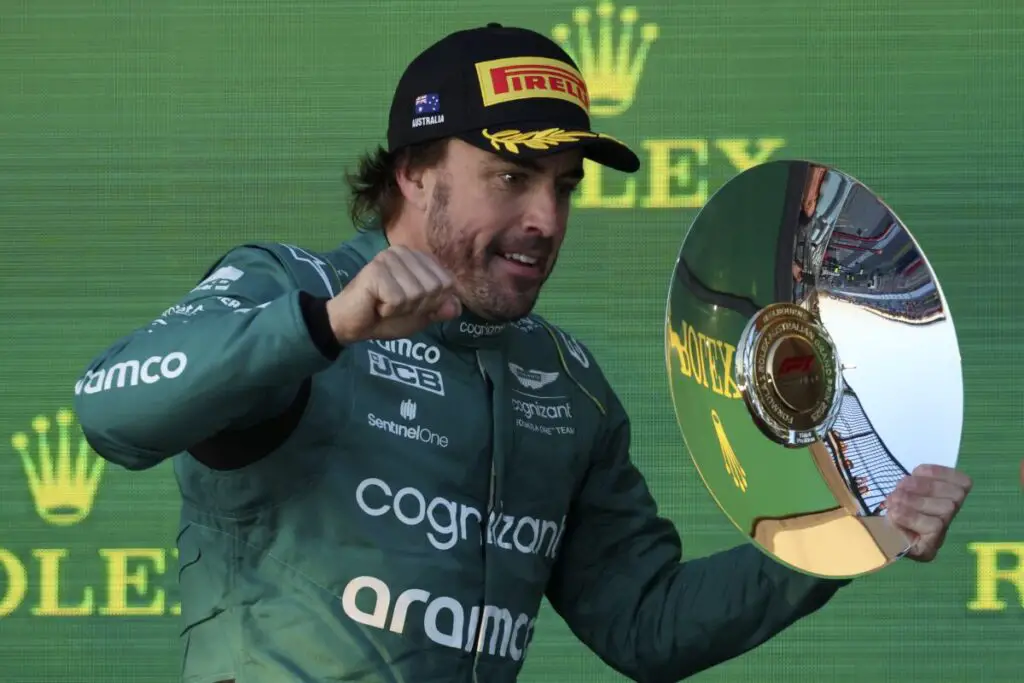
The most successful Spanish driver of all time is Fernando Alonso.
Fernando Made his F1 debut in 2001 with Minardi.
He moved to Renault in 2003 and won his first race at Hungary that year. He became world champion in 2005 and 2006, beating Schumacher and Ferrari.
Alonso then raced for McLaren, Ferrari, and McLaren again, scoring 32 wins and 97 podiums. He left F1 at the end of 2018 but returned in 2021 with Alpine.
For 2023 he has moved to Aton Martin and has achieved podium wins in 4 of the 5 races (as at 8/5/2023.)
Carlos Sainz
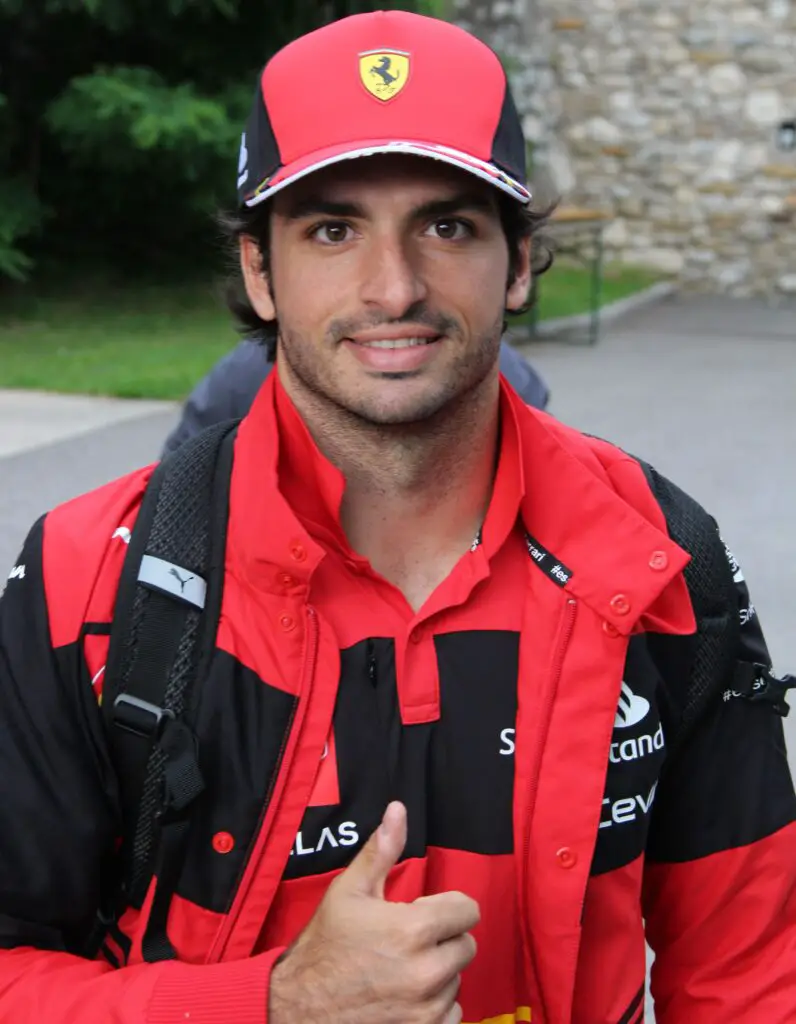
Carlos Sainz Jr. made his F1 debut in 2015 with Toro Rosso and has since raced for Renault, McLaren, and Ferrari.
At Ferrari Carlos has shown flashes of brilliance but both he and Charles Leclerc have been let down by an unpredictable Ferrari.
Tips For Attending The Spanish Grand Prix
Attending a Formula One race is an incredible experience, but it can also be overwhelming if you’re not prepared. Here are a few tips to help you make the most of your Spanish Grand Prix experience:
- Arrive early: The gates typically open several hours before the race, so be sure to arrive early to avoid the crowds and find a good spot to watch the action.
- Bring sunscreen and water: With the warm Spanish climate, it’s important to stay hydrated and protect your skin from the sun.
- Wear comfortable shoes: You’ll be doing a lot of walking around the circuit, so make sure you wear comfortable shoes that can handle rough terrain.
- Bring earplugs: Formula One cars are incredibly loud, so be sure to bring a pair of earplugs to protect your hearing.
Can you drink at the Barcelona Grand Prix?
Please don’t forget that it is forbidden to bring in any glass or cans into the circuit. Items that you are not allowed to bring to the track include the following.
- Glass containers
- metal containers
- Ceramic containers
- Wooden containers
- Alcoholic beverages
(the sale of and access to Circuit de Barcelona-Catalunya with alcoholic beverages is forbidden.
Conclusion
The Spanish Grand Prix is a must-see event for any motorsport enthusiast. With its rich history, thrilling circuit, and talented drivers and teams, there is always the potential for excitement and drama. Whether you’re attending the race in person or watching from home, the Spanish Grand Prix is sure to provide an unforgettable experience. So rev up your engines and get ready for a weekend of high-speed action!

